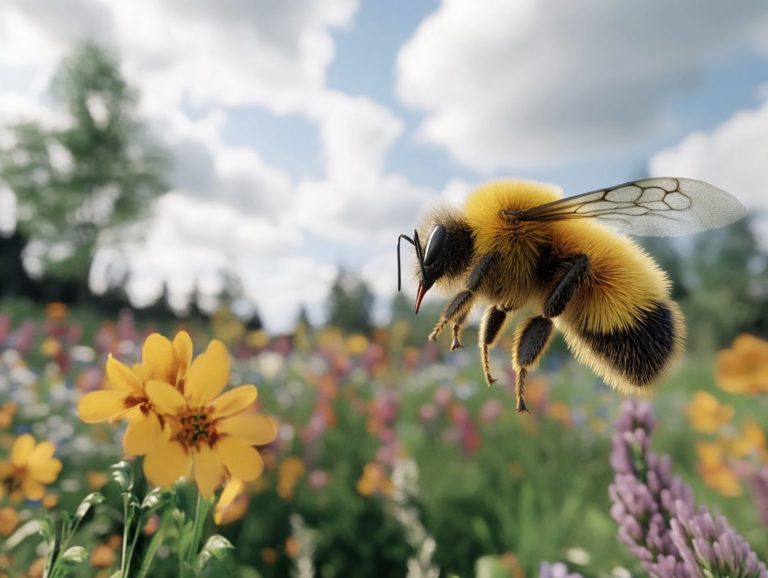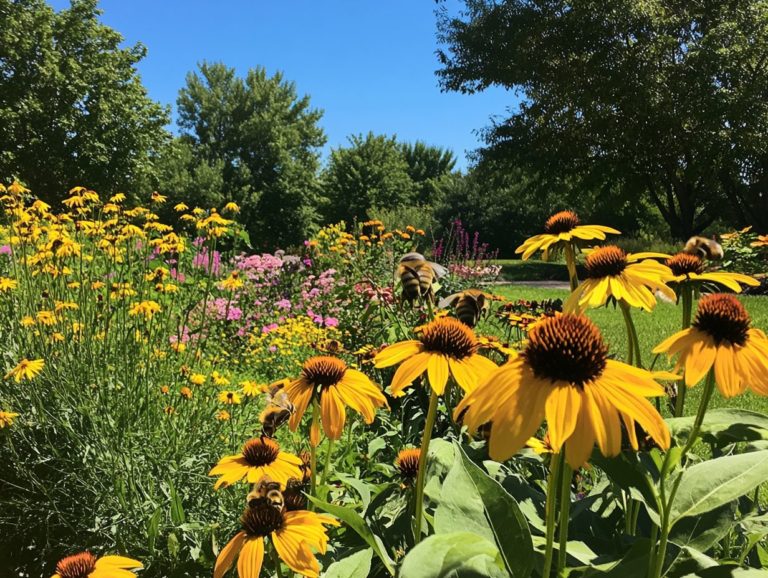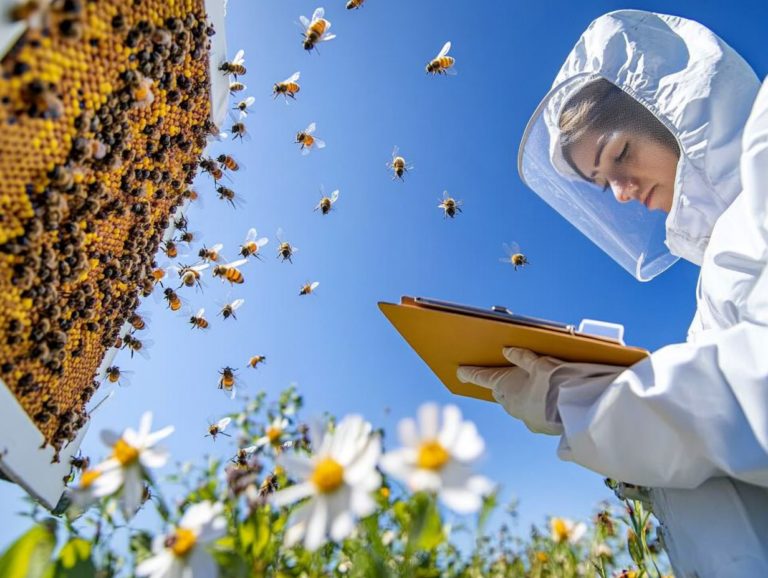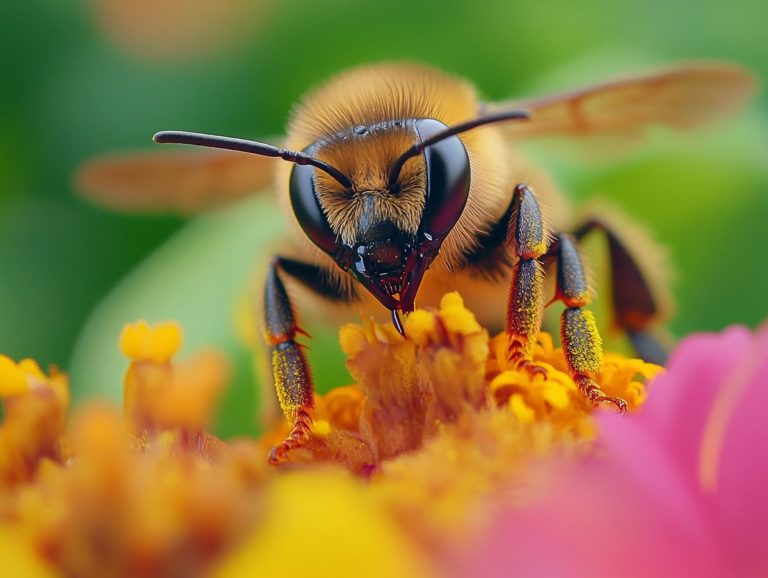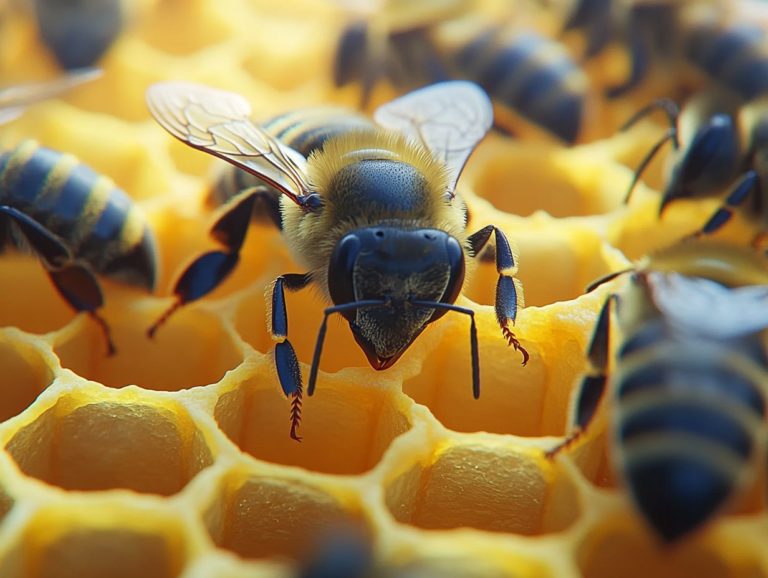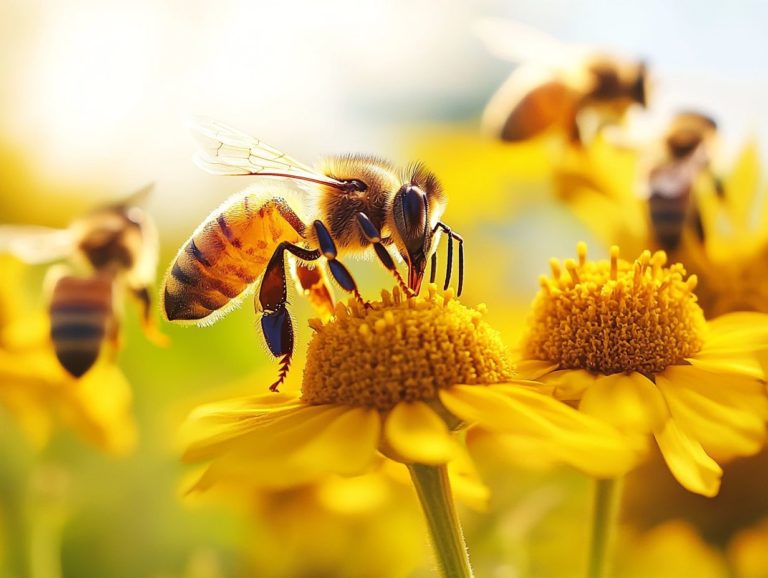The Benefits of Native Bee Species
Native bee species, including solitary bees and the familiar honey bee (Apis mellifera), are essential to our ecosystems. They help plants grow by spreading pollen, supporting biodiversity, and enhancing agricultural productivity.
As these unsung heroes of nature confront an array of escalating threats, including habitat loss and climate change, it’s vital to understand how important they are for the health of our environment.
In this exploration, you will uncover the myriad benefits that native bees provide. You will learn about their vital contributions to pollination and ecosystems, the dangers they face, and practical steps you can take to protect them through conservation efforts and pest management strategies.
By protecting these bees, we can ensure a healthier planet for future generations and contribute to raising the collective consciousness about their importance.
Contents
- Key Takeaways:
- What Are Native Bee Species?
- Why Are Native Bee Species Important?
- What Are The Threats To Native Bee Species?
- What Are The Benefits Of Native Bee Species?
- How Can We Support And Protect Native Bee Species?
- Frequently Asked Questions
- What are native bee species?
- How do native bee species benefit the environment?
- What are the advantages of using native bee species for pollination?
- How do native bee species contribute to biodiversity?
- What are the economic benefits of native bee species?
- How can we support and protect native bee species?
Key Takeaways:
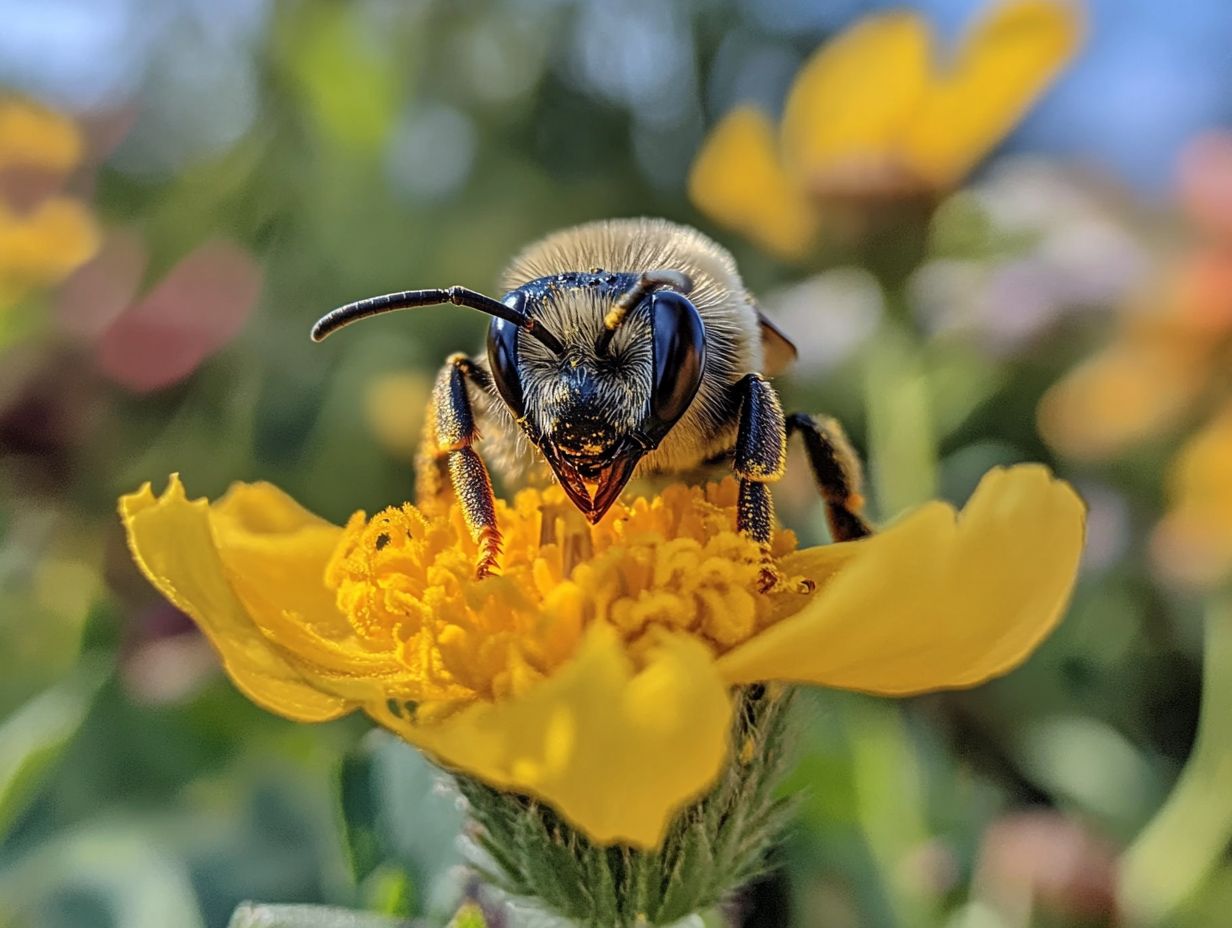
- Native bee species play a crucial role in pollination, contributing to the growth of native plants and crops.
- The preservation of native bee species contributes to plant diversity and the resilience of ecosystems.
- Supporting and protecting native bee species can lead to sustainable agriculture and potential medical and scientific discoveries.
What Are Native Bee Species?
Native bee species, including solitary bees and the familiar honey bee (Apis mellifera), are vital to our ecosystems. They play a key role in pollination and supporting flowering plants.
Their role extends to maintaining pollinator habitats and the overall environmental impact of ecosystems. These diverse bee species are crucial for the health of agricultural crops and natural habitats, each uniquely adapted to particular environments and floral resources.
Understanding native bees is essential, as they exhibit a wide range of behaviors and habitat preferences. These directly influence plant diversity and the integrity of ecosystems across various regions.
This includes urban settings like New York, where initiatives such as the Empire State Native Pollinator Survey are actively conducted to explore and appreciate these essential pollinators. Experts like Scott Black from the Xerces Society and Rachael Winfree have been instrumental in these efforts.
Why Are Native Bee Species Important?
Native bee species play a critical role in our ecosystems. They deliver essential pollinator services that bolster flowering plants and agricultural crops, ultimately enhancing both plant diversity and food security.
Among these vital pollinators are bumblebees and solitary bees, each exhibiting unique behaviors that optimize their foraging efficiency for nectar and pollen. This efficiency sustains wild plant populations and supports cultivated crops like almonds and lemons.
Experts like Claire Kremen and organizations such as USGS have highlighted the importance of these behaviors. The impact of their pollination efforts on agricultural systems and natural ecosystems is profound, underscoring the necessity of prioritizing their conservation for the health of the environment.
This is particularly important in regions like California, where agriculture depends heavily on effective pollination services.
What Is Their Role In Pollination?
The role of native bee species in pollination is absolutely vital. These industrious little creatures are primarily responsible for transferring pollen from one flower to another. This is essential for fertilization and the production of seeds and fruits. This process supports the reproduction of flowering plants and bolsters biodiversity within pollinator habitats.
You ll find that different bee species, including solitary and social bees, possess unique adaptations. These adaptations make them remarkably efficient pollinators. This efficiency ensures that both native flowering plants and agricultural crops like fruits and vegetables thrive in diverse ecosystems.
As these bees gather nectar for energy and pollen for protein, they play a crucial role in sustaining various plant species. Their foraging can lead them to visit hundreds of flowers, highlighting their essential contribution to cross-pollination, which is the process of transferring pollen between flowers. This helps plants grow seeds and fruits and is especially beneficial for promoting genetic diversity among native flowering plants.
The impressive array of native bee species, from bumblebees to mason bees, occupy specific niches. They contribute to ecological balance in unique ways. Their behaviors and interactions with plants have been a focus of study for many conservation biologists.
This specialization enables optimized pollination across various environments. This leads to healthier ecosystems where both wild and cultivated plants can flourish. In turn, this enhances food production and secures habitats for countless organisms, making the presence of native bees critical to our environment.
How Do They Contribute To Biodiversity?
Native bee species enhance biodiversity by facilitating the reproductive processes of various flowering plants. This supports the intricate web of life within ecosystems. Your appreciation of their pollination efforts is well-placed, as these tiny workers ensure that various native plants successfully reproduce, increasing plant diversity.
This diversity is vital. It provides habitats and food sources for wildlife, creating a stable and resilient ecosystem where pollinator services flourish. This ultimately benefits agricultural landscapes as well.
When native bees visit flowers, they assist in transferring pollen. This allows plants to produce seeds and fruit while nurturing a healthy mix of plant species. This genetic diversity promotes resilience against diseases and environmental shifts. It also sustains the food web that supports countless other organisms.
Diverse plant systems often improve soil health, essential for farming practices. This enhancement can lead to better crop yields and reduced reliance on chemical fertilizers.
Recognizing the role of native bee populations in promoting plant diversity highlights the interconnectedness of healthy ecosystems and productive agricultural environments.
What Is Their Impact On Agriculture?
Native bees are game-changers for agriculture! Their pollination power boosts yields and quality like nothing else. Their activities significantly enhance both the yield and quality of a wide variety of agricultural crops.
By expertly transferring nectar and pollen among plants, these bees play a vital role in the successful reproduction of essential crops, including fruits, vegetables, and nuts. We must keep native bee populations healthy because they are crucial for pollination, especially given the threats posed by habitat loss and other environmental challenges.
Their ecological role extends beyond mere pollination. Native bees foster biodiversity within ecosystems, supporting other wildlife and helping to create resilient agricultural systems. The increase in yields and improved crop quality translates into higher profits for farmers and bolsters food security for communities as a whole. This highlights the need for sustainable practices in agriculture.
However, agricultural systems face challenges such as pesticide use, monoculture practices, and climate change, all of which can jeopardize bee populations. To tackle these issues effectively, implementing sound pest management strategies and engaging in conservation efforts like creating wildflower habitats and minimizing chemical inputs are essential for preserving both bee behavior and agricultural productivity.
What Are The Threats To Native Bee Species?
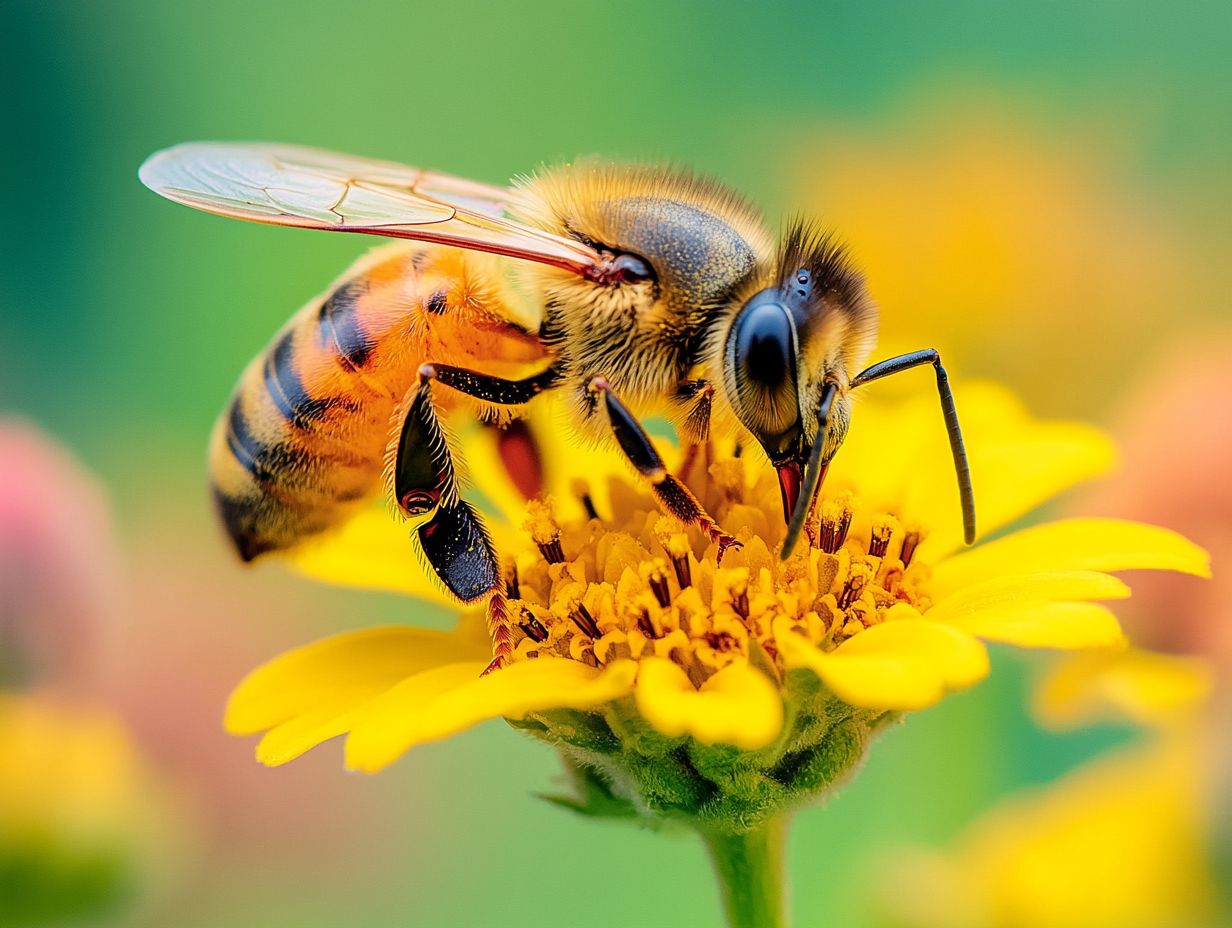
Native bee species encounter a multitude of threats that jeopardize their very existence and, in turn, the crucial ecological services they offer. Habitat loss caused by urbanization, agriculture, and climate change dramatically transforms the environments where these bees flourish. This results in declining populations and reduced pollinator services.
Furthermore, the detrimental effects of pesticides and harmful practices intensify their struggle. We must act now to protect these vital pollinators! Protecting these essential species is crucial to ensure they continue to perform their critical roles within ecosystems and agriculture.
What Are The Main Causes Of Decline In Native Bee Populations?
The decline in native bee populations is a concerning issue linked to several key factors, including habitat loss, pesticide use, and climate change. All of these factors present significant challenges to their survival.
As urban areas expand and agriculture intensifies, the natural habitats that bees depend on for nesting and foraging are increasingly diminished. This results in reduced populations of various bee species.
The use of pesticides impacts not just direct mortality rates but also disrupts the ecological balance. This exacerbates the adverse effects of climate change on bee behavior and life cycles.
Research indicates that loss of habitat, driven by human development and monoculture farming practices, severely limits the availability of food resources and nesting sites for native bees. This decline is further worsened by the escalating use of a type of pesticide known as neonicotinoids, which impair bee foraging practices and reproduction.
Climate change also alters flowering times and the seasonal availability of resources, creating a mismatch in the timing essential for bees to thrive. Together, these interconnected factors create a precarious situation that threatens not only the survival of bees but also the vital pollination services they provide to ecosystems and agriculture.
This highlights why we must urgently conserve these essential species, as emphasized by conservation biologists and ecologists.
How Does Climate Change Affect Native Bee Species?
Climate change presents a complex threat to native bee species, affecting their habitats, foraging habits, and overall survival rates. As temperatures rise and weather patterns grow increasingly erratic, the timing between flowering plants and bee activity begins to misalign. This mismatch can drastically reduce their access to vital nectar and pollen resources.
Coupled with habitat loss, this situation poses a significant risk to the ecological roles these bees fulfill. Comprehensive conservation efforts are urgently needed to address the impacts of climate change on native pollinators.
For example, research from the University of California reveals that certain bee populations are emerging earlier in the spring than the flowers they depend on. This limits their foraging efficiency and reproductive success. The loss of habitat, often driven by urban development and agricultural practices, adds to these challenges, making it increasingly difficult for native bees to find suitable nesting sites.
Studies have also shown that specific species, such as bumblebees, are particularly sensitive to temperature fluctuations. These fluctuations can alter their foraging ranges and patterns.
This imbalance threatens the survival of the bees and undermines their crucial role in pollinating both crops and wild plants, ultimately impacting biodiversity and food security.
What Are The Effects Of Pesticides On Native Bee Populations?
Pesticides significantly harm native bee populations. They lead to declines and disrupt bees’ important roles in the ecosystem.
These chemicals cause direct deaths and also hinder how bees gather food and reproduce. This makes them even more vulnerable.
The effects of pesticides spread through ecosystems and impact farming. This highlights the urgent need for conservation efforts and safer pest management practices.
Numerous studies show this concerning trend. Exposure to neonicotinoids can weaken colonies and lower pollination efficiency.
For example, research in journals like ‘Nature’ shows that even small doses can change how bees behave when foraging and navigating.
Recognizing that ecosystems are interconnected is important. Embrace integrated pest management (IPM) strategies that protect crops and support beneficial insects.
By adopting sustainable practices, like enhancing habitat diversity and using organic alternatives, you can help bee populations thrive. This preserves the delicate balance of our ecosystems.
What Are The Benefits Of Native Bee Species?
Native bee species provide essential benefits, especially in pollination. They help maintain healthy ecosystems and support sustainable agriculture.
These remarkable pollinators boost the reproductive success of both wild and cultivated plants. This fosters greater biodiversity and resilience in ecosystems.
By prioritizing their conservation, you contribute to a balanced environment where these invaluable creatures can thrive.
1. Pollination Of Native Plants And Crops
Native bees play a critical role in pollinating both plants and crops. This is vital for food production and ecological balance.
When they gather food, they effectively transfer pollen, leading to successful fertilization and seed production. This supports diverse plant growth and enhances agricultural systems.
Crops like blueberries, cherries, and melons rely heavily on these industrious pollinators. Native bees, such as bumblebees, use a special method called buzz pollination to shake flowers and release more pollen.
This method boosts the plants’ reproductive success significantly. An efficient pollination process results in higher yields and better fruit quality.
As native bee populations decline due to habitat loss and pesticide use, preserving them is crucial. It helps maintain healthy ecosystems and secures our food supply.
2. Diverse And Resilient Ecosystems
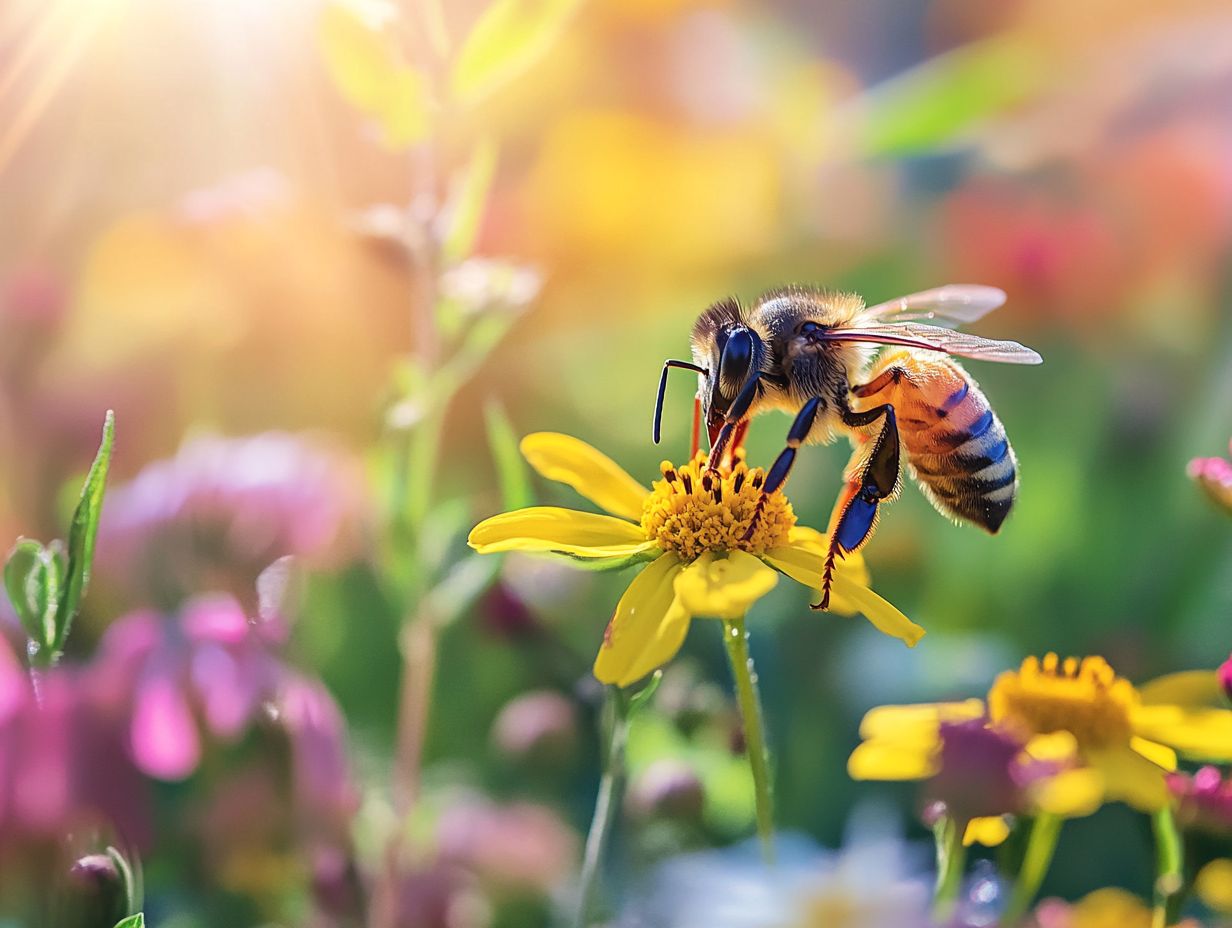
Native bees are crucial for diverse ecosystems. They facilitate pollination and help native plants grow, nurturing a variety of wildlife.
A healthy bee population is essential for the successful reproduction of flowering plants. This leads to enhanced biodiversity and a balanced ecological system.
These interconnected relationships highlight the importance of preserving native bee habitats. We must promote environmental health for the sustainability of our ecosystems.
When bees visit flowers for nectar and pollen, they move pollen from one bloom to another. This process is essential for fertilization and seed production.
This not only increases the variety of plants in an area but also strengthens connections between flora and fauna. As plant diversity rises, so does the availability of food and habitat for birds, mammals, and other insects.
The presence of native bee populations is crucial for ecosystem resilience. They enable habitats to thrive and adapt to changes from climate variations or human impacts.
By recognizing their significance, you can contribute to safeguarding these essential species. Together, we can foster a healthier environment for all living beings.
3. Sustainable Agriculture
Native bee species are vital to sustainable agriculture. Their pollination services directly impact crop yields and food security.
By boosting the reproduction of a variety of crops, these bees contribute to ecological balance. They also promote agricultural practices that are productive and environmentally sound.
Your reliance on native bees highlights the necessity of sustainable pest management strategies. We must protect these essential pollinators.
These industrious insects play a pivotal role in ensuring that plants thrive. This, in turn, supports the livelihoods of farmers and the health of local ecosystems.
Their activities stabilize and elevate crop production. They also bolster the resilience of agricultural systems against climate change and environmental fluctuations.
Act now to support these invaluable populations by adopting practices that support their habitats. This includes:
- Setting aside wildflower strips
- Avoiding harmful pesticides
- Promoting organic farming methods
By prioritizing these strategies, you can significantly enhance bee populations. This paves the way for a brighter future for both agriculture and the environment.
4. Potential Medical And Scientific Discoveries
The potential for medical and scientific discoveries tied to native bees is immense. These remarkable pollinators maintain the ecological health and biodiversity that form the foundation of countless scientific studies.
By exploring the behavior and biology of native bees, we can uncover insights that apply across various fields, including agriculture, environmental science, and even medicine. Understanding their roles within ecosystems helps protect these critical species and paves the way for innovation and discovery.
When examining how these bees interact with their environment and other species, we can reveal sustainable agricultural practices. These practices can boost crop yields while ensuring ecological balance.
For example, studying their flowering preferences and foraging patterns can inform conservation strategies. This knowledge aims to preserve habitats that nurture diverse plant life.
The insights gleaned from observing native bee behavior could even lead to the development of new pharmaceuticals. Compounds found in their natural products are gaining recognition for their potential health benefits.
In this way, the intersection of biodiversity and scientific exploration protects these essential pollinators. It also drives advancements that ultimately benefit humanity as a whole.
How Can We Support And Protect Native Bee Species?
Supporting and protecting native bee species is essential for ensuring their survival and the important roles in nature they provide. You have the opportunity to adopt several effective strategies, both individually and within your community.
Consider creating pollinator habitats, steering clear of harmful pesticides, and sharing knowledge about the significance of these crucial pollinators with others. By actively engaging in conservation efforts at multiple levels, such as those led by the Xerces Society and Empire State Native Pollinator Survey, you can help cultivate environments where native bees can thrive, ultimately benefiting biodiversity and enhancing agricultural productivity.
1. Plant Native Flowers And Plants
Planting native flowers and plants is one of the most effective strategies for supporting native bee species, including Apis mellifera. These plants offer the vital nectar and pollen resources that sustain their populations.
By incorporating a diverse range of native flowering plants into your gardens and landscapes, you can create vibrant pollinator habitats that enhance biodiversity and promote the health of local ecosystems. Experts like Rachael Winfree and Claire Kremen advocate for this practice, which benefits both bees and the beauty of your surroundings.
Consider specific species like coneflowers, goldenrods, and asters, which are particularly attractive to various types of bees, including honeybees, bumblebees, and solitary bee species. When designing pollinator-friendly spaces, blend these flowering plants to ensure they bloom at different times throughout the growing season. This guarantees food availability from early spring through late fall.
Minimizing pesticide use will also help, along with providing nesting sites such as undisturbed ground or dead wood. By embracing these best practices, you can cultivate flourishing gardens that support bee populations and inspire a deeper appreciation for the natural world.
2. Avoid Using Pesticides
Avoiding pesticides is crucial for protecting native bee species, as many chemical treatments can harm their populations and the environments they call home. By opting for organic or natural pest management strategies, you can make a big difference in ensuring the health and survival of these critical pollinators while minimizing the ecological footprint of agricultural practices.
Studies have shown the value of such methods. Supporting conservation efforts aimed at reducing pesticide use is essential for preserving biodiversity and maintaining vibrant ecosystems. Initiatives by the Xerces Society are particularly noteworthy in this regard.
Native bees are vital for pollinating a wide array of plants, directly influencing food production and ecological balance. However, the rampant use of synthetic pesticides has been linked to alarming declines in these beneficial insects’ populations, as highlighted by the Empire State Native Pollinator Survey.
As a homeowner, you can embrace safer pest control methods, such as introducing beneficial insects like ladybugs or utilizing neem oil for natural pest management. In California and other regions, successful case studies highlight these methods.
If you’re a farmer, exploring integrated pest management (IPM), which uses various strategies to control pests while minimizing harm to the environment, can lead to a more sustainable approach to crop protection. Notably, California has successfully implemented IPM methods.
By taking these thoughtful steps, you can contribute to a healthier environment that not only supports bee populations but also strengthens the overall ecosystem. Experts like Rachael Winfree stress the importance of such measures. Conservationists like Scott Black emphasize the urgency of these initiatives.
Join your neighbors in creating bee-friendly spaces! Act now to protect these essential pollinators!
3. Create Nesting Sites For Native Bees

Creating nesting sites for native bees is a vital step in helping increase their numbers and their role in the environment. Researchers like Scott Black emphasize the need for such initiatives. Many native bee species, especially solitary ones, have specific nesting requirements, such as bare soil, woody stems, or leaf litter. By providing these essential habitats, you can significantly enhance pollinator environments and play a crucial role in conservation efforts aimed at protecting these critical species from further decline. Programs by the USGS offer guidance on how to create these habitats.
You can achieve this in several ways, as Scott Black of the Xerces Society recommends:
- Setting up bee hotels, which are structures that mimic natural nesting sites for bees,
- Digging sandy patches for burrowing, or
- Simply leaving dead plant stems and fallen branches undisturbed.
These structures provide important nesting spaces and encourage various behaviors among bees, such as foraging and reproductive activities. In regions like California, such efforts have shown significant positive impacts.
By cultivating a diverse array of nesting sites, you engage in a comprehensive conservation strategy that caters to the unique needs of multiple species. This approach ultimately fosters healthier ecosystems and boosts agricultural productivity, making your efforts all the more impactful. Leading experts such as Rachael Winfree and Claire Kremen advocate for these comprehensive conservation strategies.
4. Educate Others About The Importance Of Native Bees
Educating others about the importance of native bees is an impactful way for you to advocate for their protection and bolster conservation efforts. Organizations like the Xerces Society and experts like Rachael Winfree provide valuable resources for this. By raising awareness of the vital roles these pollinators play in maintaining biodiversity and agricultural productivity, you can inspire action within your community to create environments that support bee health. In New York, local initiatives have successfully mobilized communities, collaborating on education, outreach, and engagement to foster a collective consciousness around the well-being of native bees. The Empire State Native Pollinator Survey exemplifies such collaborative efforts.
Hosting workshops that focus on the life cycles and habitats of these critical creatures enables you and your attendees to cultivate bee-friendly gardens, promoting the growth of native flora that supports local ecosystems. Experts like Claire Kremen often lead such informative sessions. Informational campaigns can leverage social media and community events to spotlight the urgent need for conservation, while school programs can introduce young minds to the captivating world of bees through hands-on activities. Pioneers like Scott Black demonstrate the effectiveness of such educational approaches.
By nurturing a sense of camaraderie and shared responsibility, you can significantly enhance community involvement in protecting native bee populations, ultimately contributing to a healthier environment for everyone. Advocates like Rachael Winfree and Scott Black emphasize the importance of community-based efforts.
Frequently Asked Questions
What are native bee species?
Native bee species are bees that naturally exist in a region and are adapted to thrive there.
How do native bee species benefit the environment?
Native bee species play a vital role in pollination. They help maintain the balance of plants and animals in an ecosystem and ensure food security for both humans and animals. Experts like Scott Black show how important they are.
What are the advantages of using native bee species for pollination?
Native bee species understand the local environment better than non-native bees. This makes them more efficient pollinators, resulting in higher crop yields and better quality produce.
How do native bee species contribute to biodiversity?
Native bee species are essential for pollination. They help sustain the diversity of plant and animal species in an area.
What are the economic benefits of native bee species?
Native bee species provide a sustainable and cost-effective alternative to non-native bees. This leads to significant savings for farmers and increased profits for beekeepers, especially in agricultural hubs like California.
How can we support and protect native bee species?
Support native bee species by promoting biodiversity and reducing pesticide use. Create suitable habitats by planting native plants and flowers. Collaborative efforts by organizations like the Xerces Society and USGS are key to these initiatives.
Join the movement to protect native bees and ensure a vibrant future for our ecosystems!

